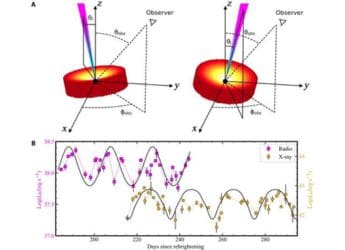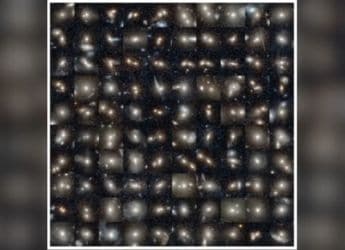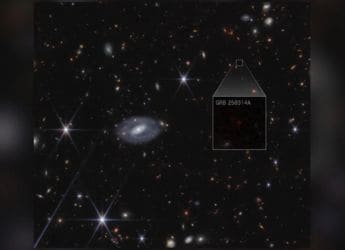- Home
- Science
- Science News
- NASA Engineers Rescue JunoCam with Deep Space Heating Hack
NASA Engineers Rescue JunoCam with Deep-Space Heating Hack
NASA engineers revived JunoCam, damaged by Jupiter’s radiation, using heat.

Photo Credit: NASA/JPL-Caltech/SwRI/MSSS Image processing by Gerald Eichstädt
JunoCam faced issues after enduring Jupiter’s extreme radiation during multiple orbits
NASA's Juno spacecraft, in orbit around Jupiter, had a huge problem when its JunoCam imager started to fail after sitting through the planet's harsh radiation belts for so many orbits. Designed to only last through the initial few orbits, JunoCam astonishingly endured 34 orbits. Yet by the 47th orbit, the effects of radiation damage became visible, and by the 56th orbit, images were almost illegible. With few alternatives and time slipping away before a close flyby of Jupiter's volcanic moon Io, engineers made a daring but creative gamble. Employing an annealing process, they sought to resuscitate the imager by warming it up—an experiment that proved successful.
Long-distance fix
According to NASA, JunoCam's camera resides outside the spacecraft's radiation-shielded interior and is extremely vulnerable. After several orbits, it started developing damage thought to be caused by a failing voltage regulator. From a distance of hundreds of millions of miles, the mission team implemented a last-ditch repair: annealing. The technique, which subjects materials to heat in order to heal microscopic defects, is poorly understood but has been succeeding in the lab. By heating the camera to 77°F, scientists wished to reorient its silicon-based parts.
At first, efforts were for naught, but only days before the December 2023 flyby of Io, the camera unexpectedly recovered—restoring close-to-original image quality just in time to photograph previously unseen volcanic landscapes.
Radiation Lessons for the Future
Though the camera showed renewed degradation during Juno's 74th orbit, the successful restoration has led to broader applications. The team has since applied similar annealing strategies to other Juno instruments, helping them withstand harsh conditions longer. Juno's findings are now informing spacecraft design across the board. “We're learning how to build radiation-tolerant systems that benefit both defense and commercial satellites,” said Juno's principal investigator Scott Bolton. These findings would inform future missions, such as those visiting outer planets or working in high-radiation environments near Earth, in the Van Allen belts. Juno's mission continues to pay dividends with unexpected innovations—a lesson in how a small amount of heat can do wonders.
Get your daily dose of tech news, reviews, and insights, in under 80 characters on Gadgets 360 Turbo. Connect with fellow tech lovers on our Forum. Follow us on X, Facebook, WhatsApp, Threads and Google News for instant updates. Catch all the action on our YouTube channel.
Related Stories
- Samsung Galaxy Unpacked 2025
- ChatGPT
- Redmi Note 14 Pro+
- iPhone 16
- Apple Vision Pro
- Oneplus 12
- OnePlus Nord CE 3 Lite 5G
- iPhone 13
- Xiaomi 14 Pro
- Oppo Find N3
- Tecno Spark Go (2023)
- Realme V30
- Best Phones Under 25000
- Samsung Galaxy S24 Series
- Cryptocurrency
- iQoo 12
- Samsung Galaxy S24 Ultra
- Giottus
- Samsung Galaxy Z Flip 5
- Apple 'Scary Fast'
- Housefull 5
- GoPro Hero 12 Black Review
- Invincible Season 2
- JioGlass
- HD Ready TV
- Laptop Under 50000
- Smartwatch Under 10000
- Latest Mobile Phones
- Compare Phones
- Redmi Note 15 5G
- Redmi Note 15 Pro 5G
- Redmi Note 15 Pro+ 5G
- Lava Play Max
- Poco C85 5G
- Honor Magic 8 Lite
- Jolla Phone
- Realme P4x 5G
- Asus ProArt P16
- MacBook Pro 14-inch (M5, 2025)
- OnePlus Pad Go 2
- Poco Pad M1
- Just Corseca Skywatch Pro
- Honor Watch X5
- Acerpure Nitro Z Series 100-inch QLED TV
- Samsung 43 Inch LED Ultra HD (4K) Smart TV (UA43UE81AFULXL)
- Asus ROG Ally
- Nintendo Switch Lite
- Haier 1.6 Ton 5 Star Inverter Split AC (HSU19G-MZAID5BN-INV)
- Haier 1.6 Ton 5 Star Inverter Split AC (HSU19G-MZAIM5BN-INV)

















